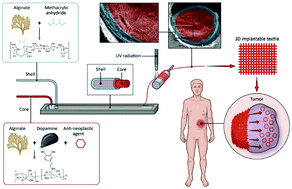Coaxial mussel-inspired biofibers: making of a robust and efficacious depot for cancer drug delivery†
Abstract
Biopolymer-based hydrogels have emerged as promising platforms for drug delivery systems (DDSs) due to their inherent biocompatibility, tunable physical properties and controllable degradability. Yet, drug release in majority of these systems is solely contingent on diffusion of drug molecules through the hydrogel, which often leads to burst release of drugs from these systems. Herein, inspired by the chemistry of mussel adhesive proteins, a new generation of coaxial hydrogel fibers was developed that could simultaneously exert both affinity and diffusion control over the release of chemotherapeutic drugs. Specifically, dopamine-modified alginate hydrogel along with chemotherapeutic drugs (doxorubicin or gemcitabine) was used as the main core component to confer affinity-controlled release, while a methacrylated-alginate hydrogel was used as the shell composition to provide the controlled diffusion barrier. It was shown that our coaxial mussel-inspired biofibers yielded biocompatible hydrogel fibers (as indicated by comprehensive in vitro and in vivo experiments) with favourable properties including controlled swelling, and enhanced mechanical properties, when compared against single fibers made from unmodified alginate. Notably, it was observed that these coaxial fibers were capable of releasing the two drugs in a slower manner, when compared to single fibers made from pure alginate, which was partly attributed to stronger interactions of drugs with dopamine-modified alginate (the core element of coaxial fibers) as observed from zeta-potential measurements. It was further shown that these drug-loaded coaxial fibers had optimal anticancer activity both in vitro and in vivo using various pancreatic cancer cell lines. Most remarkably, drug loaded coaxial fibers, particularly doxorubicin-containing fibers, had higher anticancer effect in vivo compared to systemic injection of equivalent dosage of the drugs. Altogether, these biocompatible and robust hydrogel fibers may be further used as neoadjuvant or adjuvant therapies for controlled delivery of chemotherapeutic drugs locally to the tumor sites.



 Please wait while we load your content...
Please wait while we load your content...